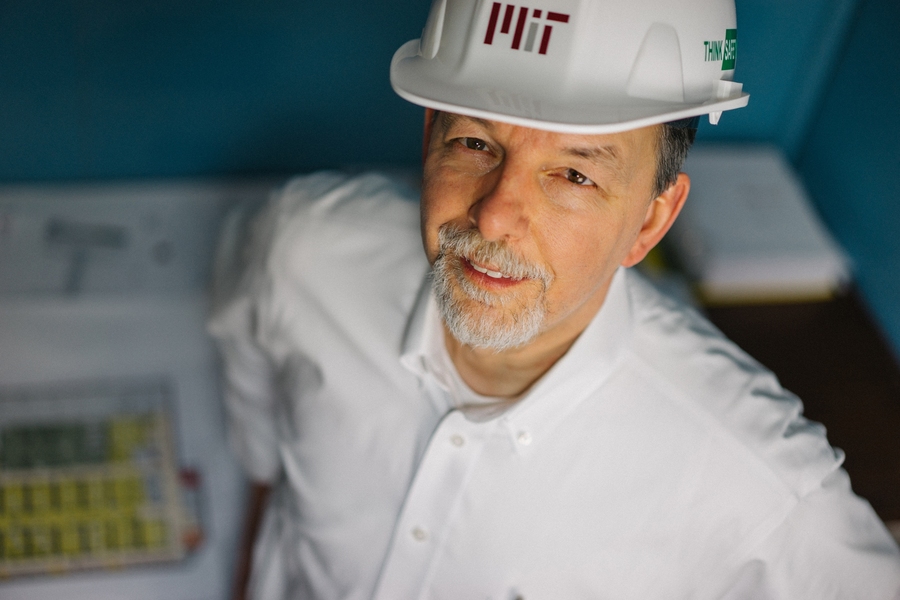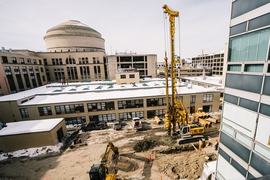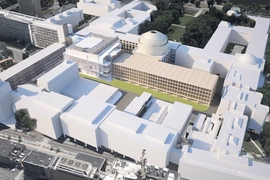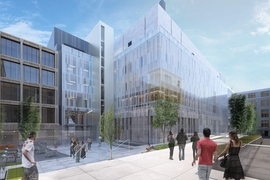It’s not hard to imagine Dennis Grimard as that guy on a unicycle keeping a chainsaw, bowling ball, and lit torch aloft. While his day job isn’t quite that dangerous, the new associate director of MIT.nano still performs a tricky balancing act while he climbs a steep learning curve and hones his listening and consensus-building skills at the same time. Grimard, who started at MIT in late December, joins a vast team of MIT staff and faculty, consultants, architects, and contractors who are planning the construction of one of the most ambitious research facilities in Institute history. Once the building is up and running, Grimard will manage its operations. It is, he says, “the challenge of a lifetime.”
Grimard has spent the last few months reviewing thousands of pages of blueprints and technical documents that outline the 200,000-square-foot nanotechnology laboratory and fabrication center. MIT gave the go-ahead on MIT.nano in 2013. Since then, a group led by Arne Abramson and Travis Wanat from the Department of Facilities, Vladimir Bulović from the School of Engineering, and other staff from across the Institute have worried through the millions of details associated with getting the building built. Showing up this late in the process, Grimard says, defines his first challenge: just catching up.
As he absorbs the details of the building design and its construction plans, Grimard also tries to stay mindful of his second task: running it smoothly after it opens. Since MIT.nano will accommodate the work of 2,000 scientists and engineers from all over MIT, he is responsible “for putting all these successful researchers together in the same building and making sure they can all work together without an adverse increase in entropy,” he says.
It’s the kind of complex, multi-variable problem Grimard relishes. He came to MIT from the University of Michigan, where he received his PhD in electrical engineering, consulted for leading semiconductor firms such as Applied Materials and Novellus designing tools and processes (he has 31 patents). Grimard spent his early years at Michigan as a research scientist, but his central accomplishment there was helping plan, launch, and manage the Lurie Nanofabrication Facility (LNF), a 13,500 square-foot cleanroom facility. As managing director of the LNF, he developed a taste for handling nitty-gritty safety and environmental details while balancing the needs of stakeholders with competing and, more often than not, divergent needs.
This experience and the lessons that came with them have already proven invaluable at MIT. “Every piece of every project has value; every person, from top to bottom, has value. If I can’t understand that value, I won’t succeed,” Grimard says. Between studying reams of architectural designs for what he believes will be “one of the most environmentally conscious buildings on the planet,” and weighing in on such questions as the right place for scrubbers and drains, Grimard’s long days involve “walking into offices like an uninvited guest, and asking what I need to know to do my job right and add value to your research.”
This means meeting with — and trying to bridge any gaps between — the teams responsible for designing and constructing the new building, faculty, researchers, and the technicians who will use MIT.nano when it opens in 2018. Grimard sprints between spending time “as a fly on the wall” in different labs to see how research groups operate to meetings with MIT Facilities to talk about the plans for the building. “I tell the researchers I need to learn what they do so when I see them in the new building they’re smiling and don’t want to kill me.”
Grimard views one his greatest tasks as creating a governance and financial model that all research groups buy into — one that is “transparent, incorporates everybody’s ideas, and clearly benefits the entire community.” This will be “wicked hard,” he admits, “but I’m very persistent and creative.” The enterprise reminds him of “being a new parent, where you don’t get to sleep for years, but the rewards and pleasures are ultimately immense.” He is in it for the long haul, Grimard says, “because I’ve always dreamed of being at MIT. And now, working on the world’s greatest project, how could I not want to do this?”









